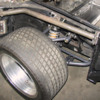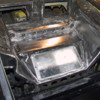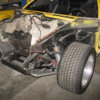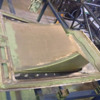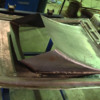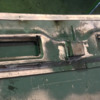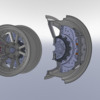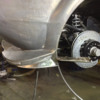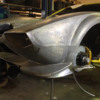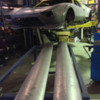Nice metalwork and a lot of it! The only known reason for pop-up headlights in any car are the old headlight-height laws some areas specified for unknown reasons. They seem to have mostly gone away.
The GT-40-look hood exhaust requires cutting the front section of the front trunk away, and that part is a structural part of the Pantera's front monococque, so I suggest some sort of bracing should be added back. I put an aluminum angle-iron crossmember between the lower frame rails behind the steering rack, and it not only stiffened up the front structure, its what my dropped battery sits on with no battery box needed.
There has been allot of extra strengthening added.
This is a bolt in bar that ties the new nose structure in with the shock tower, the top chassis rail & the bolt in internal rollbar structure in the cabin.
Drilled & tapped plates are welded into the chassis for it to bolt to.
regards,
Tony.
This is a bolt in bar that ties the new nose structure in with the shock tower, the top chassis rail & the bolt in internal rollbar structure in the cabin.
Drilled & tapped plates are welded into the chassis for it to bolt to.
regards,
Tony.
Attachments
This is the crossmember added between the shock mount area.
You can also see the recessed battery box which is a bolt in alloy item.
The panel work has been re-plated around the box to stiffen that area.
The new nose structure which is welded into the chassis is also a thicker material.
regards,
Tony.
You can also see the recessed battery box which is a bolt in alloy item.
The panel work has been re-plated around the box to stiffen that area.
The new nose structure which is welded into the chassis is also a thicker material.
regards,
Tony.
Attachments
You can see here, when the nose was first cut off a section of RHS added between the very front mount point of the lower suspension arm.
This RHS also gives a sturdy area for the new nose to weld to.
You can also see wing plates added forward of the upper suspension arm mount point.
These plates not only tied in some of the flappy panel work to the upper chassis rails, but gave the mounting point for the bolt in bar work, (shown above) & again a weld point for the new nose.
regards,
Tony.
This RHS also gives a sturdy area for the new nose to weld to.
You can also see wing plates added forward of the upper suspension arm mount point.
These plates not only tied in some of the flappy panel work to the upper chassis rails, but gave the mounting point for the bolt in bar work, (shown above) & again a weld point for the new nose.
regards,
Tony.
Attachments
Tony can I send you my pantera from Sydney for sill replacements.....  Wow looks stunning.
Wow looks stunning.
Interesting you mention the sills, (rockers).
The reason I took the car off the road in the first place was to do some panel work to the left side sill.
Someone had jacked up the car, let it down too quick & crunched the sill.
That exposed layers of bog, (Bondo) which made me see red!
Hate bog in nice cars.
The silly thing is, we have replaced just about every panel on the car except for the roof skin.....................and the sills.
The very reason the car was taken off the road was those sills. And although we have cut them off, new ones are still yet to be made.
I'm fitting a 38x2.6 CDS tube the length of the sill, which will be tucked up inside & welded into the chassis before the sill goes on.
Tied into this tube will be pickup plates where the main rollbar hoop & rollcage sections bolt in.
So all bolt in rollcage tubes tie in together, but some are hidden away & become part of the structure.
regards,
Tony.
The reason I took the car off the road in the first place was to do some panel work to the left side sill.
Someone had jacked up the car, let it down too quick & crunched the sill.
That exposed layers of bog, (Bondo) which made me see red!
Hate bog in nice cars.
The silly thing is, we have replaced just about every panel on the car except for the roof skin.....................and the sills.
The very reason the car was taken off the road was those sills. And although we have cut them off, new ones are still yet to be made.
I'm fitting a 38x2.6 CDS tube the length of the sill, which will be tucked up inside & welded into the chassis before the sill goes on.
Tied into this tube will be pickup plates where the main rollbar hoop & rollcage sections bolt in.
So all bolt in rollcage tubes tie in together, but some are hidden away & become part of the structure.
regards,
Tony.
Amazing work, Tony. God bless 
Some fine work there Tony. Great design, execution, and craftsmanship. Well done.
Best,
Kelly
Best,
Kelly
Your sheet metal work is fantastic. Love it.
I can't help but compare the addition chassis tubing to what Hall did with "Purple passion", the t-top car.
I suppose when it comes down to it, there are only a few places to put it though in the spaces that are available to the car?
One thought I had was that if the original sheet metal in the outer/inner rockers, i.e.,"pontoons" itself could have been made of a thicker steel, then it could eliminate the need for the tubing?
I thought about what you did also, BW, with the aluminum L's but shouldn't that have been steel?
All of this "investigation" is really just showing me the flexibility of the front of the "monococque".
The first time I saw the front of the GT40 chassis with the nose up, it scared the heck out of me.
It was essentially just made up of 1" square, 1/8" wall tubing with very suspicious looking welds.
I think much like the original Pantera, when you design it for 6-7" wide rims with 185 profile tires it doesn't bring out the weaknesses to the design.
When you start to squeeze 285-30 profile tires on 10" wide rims, all the monsters start coming out of the closets?
It just makes me think, why not just cut the entire front chassis off of the car and build a complete bird cage for it? Where does this stop?
Now if you are thinking to yourself I wish Doug really would stop this thinking business, you aren't the first one to come to that conclusion.
I had a Professor threaten to duct tape me shut and put me in the corner facing the wall.
Also, I debate things with myself as well so don't feel singled out. It gets really ungly when I grab myself by the throat and beat my head against the wall.
At least the pain from that keeps me from thinking for a while but the pain starts me moaning from the discomforts? Go figure?
I can't help but compare the addition chassis tubing to what Hall did with "Purple passion", the t-top car.
I suppose when it comes down to it, there are only a few places to put it though in the spaces that are available to the car?
One thought I had was that if the original sheet metal in the outer/inner rockers, i.e.,"pontoons" itself could have been made of a thicker steel, then it could eliminate the need for the tubing?
I thought about what you did also, BW, with the aluminum L's but shouldn't that have been steel?
All of this "investigation" is really just showing me the flexibility of the front of the "monococque".
The first time I saw the front of the GT40 chassis with the nose up, it scared the heck out of me.
It was essentially just made up of 1" square, 1/8" wall tubing with very suspicious looking welds.
I think much like the original Pantera, when you design it for 6-7" wide rims with 185 profile tires it doesn't bring out the weaknesses to the design.
When you start to squeeze 285-30 profile tires on 10" wide rims, all the monsters start coming out of the closets?
It just makes me think, why not just cut the entire front chassis off of the car and build a complete bird cage for it? Where does this stop?
Now if you are thinking to yourself I wish Doug really would stop this thinking business, you aren't the first one to come to that conclusion.
I had a Professor threaten to duct tape me shut and put me in the corner facing the wall.
Also, I debate things with myself as well so don't feel singled out. It gets really ungly when I grab myself by the throat and beat my head against the wall.
At least the pain from that keeps me from thinking for a while but the pain starts me moaning from the discomforts? Go figure?
Doug, most of my mods are of the 'looks OK- lets try it' type. I had a length of 1-1/2" x 3/16" aluminum L and a need for a dropped battery support. The piece is so short (less than 12" I think) the material is unimportant, given its multifunction. And I LIKE light-alloy! A suspension cross-brace probably should be between the upper frame stubs, not the lowers but I had also discarded Bill Stropp's rack-brace when I did the factory-type bump-steer mod. So I thought I ought to attempt a little stiffening in the vicinity.
As far as 'flexible fronts', Larry Stock's SS Pantera once hit a hump-backed bridge at 150+ mph and flew nearly 140 ft during an event. On landing, the entire lower front frame assembly cracked off the areas where it was factory-welded to the tub. Had he not had a welded-on chassis bracing system, things might not have turned out so good. As it was, Larry and his navigator picked up their trophy and drove the '73 200 miles back to Carson City without noticing the front frame extensions had broken free. Surprisingly, the much heavier rear area was unaffected & held its alignment specs. Too bad I couldn't mention this to Carroll Smith who thought the main problem with Pantera 'racers' would be in the rear assembly.
As far as 'flexible fronts', Larry Stock's SS Pantera once hit a hump-backed bridge at 150+ mph and flew nearly 140 ft during an event. On landing, the entire lower front frame assembly cracked off the areas where it was factory-welded to the tub. Had he not had a welded-on chassis bracing system, things might not have turned out so good. As it was, Larry and his navigator picked up their trophy and drove the '73 200 miles back to Carson City without noticing the front frame extensions had broken free. Surprisingly, the much heavier rear area was unaffected & held its alignment specs. Too bad I couldn't mention this to Carroll Smith who thought the main problem with Pantera 'racers' would be in the rear assembly.
When most are speaking of these radical modifications whether it be sheet metal or just chassis, there is no point in doing this just for the jollies.
I would think if serious racing was involved as in Larry's car, I think there is significant evidence that the original monococque chassis is being over challenged?
I have always wondered what the difference between courage and stupidity is? It would be very stupid for me to go 200mph in this car.
I would think if serious racing was involved as in Larry's car, I think there is significant evidence that the original monococque chassis is being over challenged?
I have always wondered what the difference between courage and stupidity is? It would be very stupid for me to go 200mph in this car.
Most of the items I have made for my Pantera I have designed on Solidworks.
Such as the rollbar, suspension arms, font nose module, remote thermostat, 930 CV upgrade, Taper roller bearing rear upright upgrade, wheel rims etc.
If the part was structural I have conducted FEA on the part, (Finite element analysis).
Such as the nose & suspension arms & wheels.
To a certain extent there is a bit of educated guesswork involved to determine how much stress the part actually sees in the real world.
But if nothing else the program shows where the main stress areas are, the weak points.
And that means you have a better idea of where strength or stiffness is required.
It's a good tool to aid in design & removes the hit & miss approach.
regards,
Tony.
Such as the rollbar, suspension arms, font nose module, remote thermostat, 930 CV upgrade, Taper roller bearing rear upright upgrade, wheel rims etc.
If the part was structural I have conducted FEA on the part, (Finite element analysis).
Such as the nose & suspension arms & wheels.
To a certain extent there is a bit of educated guesswork involved to determine how much stress the part actually sees in the real world.
But if nothing else the program shows where the main stress areas are, the weak points.
And that means you have a better idea of where strength or stiffness is required.
It's a good tool to aid in design & removes the hit & miss approach.
regards,
Tony.
Attachments
Add Reply
Sign In To Reply


